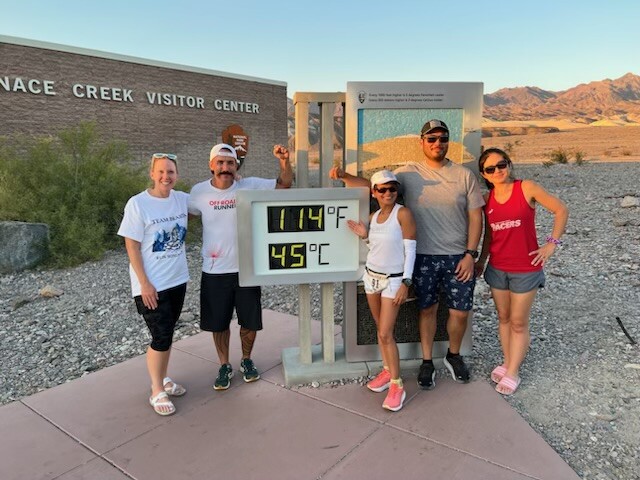Truth matters. Community matters. Your support makes both possible. LAist is one of the few places where news remains independent and free from political and corporate influence. Stand up for truth and for LAist. Make your year-end tax-deductible gift now.
Tips On Flirting With Deadly Heat From A Pro Who Ran 135 Miles Across Death Valley

Sonia Ahuja can tell you a thing or two about pushing your body to the limit in extreme heat, having finished a 135-mile run across Death Valley just this month.
“When I first heard about it, I had no idea what this race [was] about,” Ahuja said. “I had very limited experience in ultra-running when I decided to do Badwater.”
The Badwater Ultramarathon, to be precise, is the self-described “world’s toughest foot race” that pits daredevil runners against a 135-mile course between Death Valley and the mouth of Mount Whitney. Obstacles in between include a few mountain ranges, a total altitude gain of over 14,000 feet, and peak Death Valley heat.
Ahuja clocked in at 25 hours, 42 minutes and 51 seconds – earning her second place in the women’s category in the competition this July, and the fourth best time overall. The 47-year-old also became the first Indian woman to place in the top three.
Not bad for someone who discovered Badwater only about a year ago.
A top brass at an insurance company by day, the Thousand Oaks resident has always been a runner, albeit the kind that runs “in my backyard or my neighborhood.”
“I'm not a typical racer who runs longer distance races. I didn't have the resume,” she said.
To qualify for the invite-only Badwater, Ahuja entered three ultramarathons in as many months – races that are longer than the standard 26.2 miles — ultimately winning two of them.
But Badwater is a different beast altogether.
“I learned the extreme issues that runners face, whether it's heat, the elevation gain, you know, those brutal hills, the distance,” she said.
The heat, Ahuja said, was by far the toughest to train for.
“I would put on like multiple layers of clothes,” she said. “My beanie and three jackets, wool socks and I would be running the Santa Monica mountains — 4, 5, 6 hours [from] when the sun is up to sunset.”
Then there was this.
“I used to go to the sauna in my local gym,” she said. “I actually tried putting a treadmill in there and they didn't let me.”

She settled for pumping weights and doing jumping jacks inside instead.
Lately, Ahuja said she’d been getting emails about curiosity-seekers who flock to Death Valley to experience the record-breaking heat.
“I do think that you could do anything. But you have to adapt before you go,” she said.
And when you are out there: take electrolytes, drink plenty of iced water, and use ice on your body to bring the internal temperature down.
“The key is you could have a very high temperature in the environment. All that doesn't matter. But what really is it’s your own body temperature,” she said.
“I had to learn how to keep my body temperature under control. That's my key learning.”








